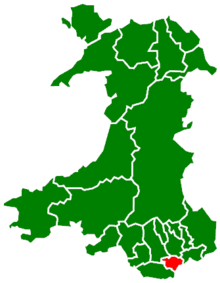Cardiff English

The Cardiff accent, also known as Cardiff English[1] is the regional accent of English, and a variety of Welsh English, as spoken in and around the city of Cardiff, and is somewhat distinctive in Wales, compared with other Welsh accents.[2] Its pitch is described as somewhat lower than that of Received Pronunciation, whereas its intonation is closer to dialects of England rather than Wales.[3]
It is estimated that around 500,000 people speak Cardiff English. The accent is generally limited to inside the city's northern boundary, rather than extending to the nearby South Wales Valleys where the spoken variety of English is different. However, the accent area spreads east and west of the city's political borders, covering much of the former counties of South Glamorgan and south-west Gwent, including Newport and coastal Monmouthshire.[4][5]
The dialect developed distinctively as the city grew in the nineteenth century, with an influx of migrants from different parts of Britain and further afield. The Cardiff accent and vocabulary has been influenced in particular by those who moved there from the English Midlands, the West Country, other parts of Wales, and Ireland.[6]
Influence
The formation of the modern Cardiff accent has been cited as having an Irish influence, similar to the influence of the Liverpool accent, given both cities' status as major world ports.[2] However recent analysis has shown the accent to have much older, local roots, the investigation uncovered findings in conflict to the view that the accent has strong origins outside of the local area, as it summarises that:
- "The Cardiff accent has been analysed by a number of dialect experts from England and they tend to emphasise the influence of immigrants from Ireland and the South West of England. But they often forget about the impact the local dialect of Welsh has had on the city's accent. Everyone knows that Cardiffians tend to pronounce their 'ah' sounds more like an 'eh' sound - for instance, 'Kairdiff' rather than 'Cardiff', 'dairk' instead of 'dark', etc. But that's exactly what local Welsh speakers would have done years ago. Turning their 'as into 'e's is one of the characteristics of 'Y Wenhwyseg' (the older, local dialect). Perhaps the non-Welsh speaking residents of Cardiff are more faithful to the original pronunciation than the Welsh speakers who have moved to the city in recent years!" [7]
According to a BBC study, the Cardiff accent, as well as that of Liverpool and East London, is in the process of changing due to the modern influence of immigration on youth, primarily of Arabic and Hindi influence.[8]
Social variation
Research has shown that there is a great sociolinguistic variation on the Cardiff accent, that is to say, a difference in the way people speak from different social backgrounds in Cardiff. Unsurprisingly, those from a more affluent background generally speak with a less broad accent, closer to that of standard English, compared with people from a working-class background.[1] Thus, the city itself has different dialects, with people from the less affluent eastern and western districts of the city having a stronger and broader accent than those living in the more affluent north Cardiff.
Accent


A common first reaction to the accent is often that it is scarcely different from what is considered a "proper Welsh accent", which is usually seen by most outside Wales as being the variety spoken in the South Wales Valleys. Cardiff English shares many phonetic traits with the English spoken in the Severnside area of England, but differs in being non-rhotic.[10]
Pitch
The pitch of the Cardiff accent is generally closer to English accents rather than Welsh, but with a higher range than in Received Pronunciation (RP). Nevertheless, the average pitch is lower than other South Wales accents and RP. The accent tends to be consistent in pitch with strong expression, such as annoyance, excitement and emphasis. Pitch is one of the factors that the Cardiff accent and other South Wales accents share most closely.[11]
Pronunciation
The accent is sufficiently distinct from standard English that researchers from the University of Birmingham have carried out research on the accent in an effort to improve speech recognition software.[12]
Place names in Cardiff, such as Crwys and Llanedeyrn, may be pronounced in a way which reflects rules of neither Welsh nor English.[6]
Dialect
Grammatical differences
- A common feature of the Cardiff accent is, in colloquial language, the tendency to use a 3rd person singular verb conjugation when referring to the 1st/2nd person singular or plural. For example, I lives in Cardiff rather than I live in Cardiff.[1]
- When asking the whereabouts of something, a Cardiffian may ask Where's that to?,[12] with the grammatically unnecessary addition of the preposition to, which indicates a direction even though this meaning would not actually be implied.
- Double negatives are a feature of Cardiff English, as in some other urban accents of English.[1]
- Cardiff English is marked by frequent assimilation and elision, when two distinct sounds merge into one when pronounced in sequence. Therefore, bearing in mind the dropping of /ð/, in these may be pronounced as [ɪnˈniːz] (in-neez), rather than [ɪn ˈðiːz].[13]
- Contrasting elements of meaning in a sentence, e.g. "I'll be over there now, in a minute."[6]
Vocabulary differences
Words and phrases generally used in South Wales and Cardiff
| lush;[12] cracking | great, fabulous, attractive |
| dap[1] | plimsole |
| to dap[1] | to bounce |
| tidy[1] | a general term of approval |
Examples
The accent can be heard in varying degrees in the voices of Frank Hennessy, Charlotte Church, Colin Jackson, Craig Bellamy and Stan Stennett.[2]
Although based in nearby Barry, accents heard in the sitcom Gavin & Stacey are not Cardiff or Barry accents, with the exception of the character Nessa, played by Ruth Jones who is from the city.[14]
Opinions
The former Assembly First Minister Rhodri Morgan pointed out in a pamphlet of Cardiff that having a strong Cardiff accent has long been an issue of class, recalling how teachers at a Cardiff high school prepared pupils for the middle class professions by reciting: "Hark, hark the lark In Cardiff Arms Park!"[2]
In a survey, carried out by the BBC, Welsh accents are among the least popular accents in the UK. However, the Cardiff accent was rated higher than that of nearby Swansea.[15]
In the 1960s, Gwyn Thomas, a Valleys man, described the speech of Cardiffians in the following way:[16]
- "The speaking voices of this city fascinate. The immigrant half, the visitors from the hills, speak with a singing intonation, as if every sentence is half-way into oratorio, the vowels as broad as their shoulders. The Cardiff speech, a compound of the native dialect and a brand of High Bristolian, gives an impression of a wordly hardness. They speak of 'Cairdiff', 'Cathays Pairk', and for a long time it is not amiable to the ear. There is an edge of implied superiority in it to the rather innocent and guiless openness of the valley-speech."
References
- 1 2 3 4 5 6 7 Google Books | World Englishes: Critical concepts in linguistics
- 1 2 3 4 Real Kairdiff BBC Accessed 2 March 2010
- ↑ Collins & Mees (1990), p. 99.
- ↑ Collins & Mees (1990), p. 87.
- ↑ The Roots of Cardiff English
- 1 2 3 Guardian Cardiff | A Cardiff Story: A migrant city
- ↑ http://www.s4c.co.uk/ffeithiol/e_arlafar7.shtml
- ↑ BBC News| East End Cockney accent 'fading'
- ↑ Collins & Mees (1990), p. 95.
- ↑ Collins & Mees (1990), pp. 87–88.
- ↑ Collins & Mees (1990), p. 101.
- 1 2 3 BBC NEWS | Wales | Computers to learn Cardiff accent
- ↑ Collins & Mees (1990), p. 98.
- ↑ Daily Mail | Gavin & Stacey: Ten things you didn't know about the popular comedy
- ↑ BBC NEWS | Wales | Welsh proud of 'unpopular' accent
- ↑ The Language of Cardiff
Bibliography
- Collins, Beverley; Mees, Inger M. (1990), "The Phonetics of Cardiff English", in Coupland, Nikolas; Thomas, Alan Richard, English in Wales: Diversity, Conflict, and Change, Multilingual Matters Ltd., pp. 87–103, ISBN 1-85359-032-0
Further reading
- Penhallurick, Robert (2004), "Welsh English: phonology", in Schneider, Edgar W.; Burridge, Kate; Kortmann, Bernd; Mesthrie, Rajend; Upton, Clive, A handbook of varieties of English, 1: Phonology, Mouton de Gruyter, pp. 98–112, ISBN 3-11-017532-0
- Windsor Lewis, Jack (1990), "The Roots of Cardiff English", in Coupland, Nikolas; Thomas, Alan Richard, English in Wales: Diversity, Conflict, and Change, Multilingual Matters Ltd., pp. 105–108, ISBN 1-85359-032-0
- Windsor Lewis, Jack (1990), "Transcribed Specimen of Cardiff English", in Coupland, Nikolas; Thomas, Alan Richard, English in Wales: Diversity, Conflict, and Change, Multilingual Matters Ltd., p. 104, ISBN 1-85359-032-0